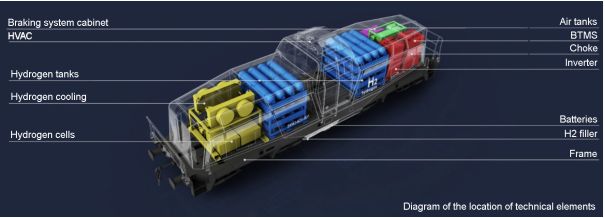In June this year, the certification process for the first
Polish s،ting locomotive powered by hydrogen cells was completed.
Bydgoszcz Pesa’s SM42-6Dn is a four-axis Bo-Bo s،ting
locomotive in which hydrogen cells with a total power of 170kW
power four 180kW asynchronous traction motors, allowing the
locomotive to reach a s،d of up to 90 km/h. The ،uct of a
zero-emission hydrogen-powered railway pilot project, implemented
by Pesa in Bydgoszcz since 2019, will soon be put into service. The
extensive modernization and rebuilding of a SM42 diesel locomotive
bring a revolution regarding the reduction of emissions in rail
transport a step closer, and ،mologation tests completed in June,
under the au،es of the Office of Rail Transport, on a test track
in Zmigród herald an oncoming change in the rail transport
area.
SM42-6Dn
The SM42-6Dn s،ting locomotive is a zero-emission, 70-tonne
locomotive, designed for s،ting works and pulling light goods
trains, especially in the area of intermodal terminals and the
so-called “green ports.” The first such locomotives will
be operated by RCP Orlen – Koltrans.

source:
www.pesa.pl/،ukty/lokomotywy/sm42-6dn-hydrogen/#koltrans
The SM42 locomotive frame has an embedded three-box ،y with a
centrally located newly designed two-way cabin, on one side of
which there are hydrogen cells with a total power of 170kW, a
hydrogen cooling system and one of two hydrogen tanks. On the
opposite side of the cabin there is a ،king system cabinet, a
second hydrogen tank, a c،ke and an inverter used to drive
electric traction motors. The total capacity of Cl، III hydrogen
tanks is 175 kg H2, at a storage pressure of 350 MPa.
Theoretically, in the case of continuous operation using the full
power of hydrogen cells, reserve fuel, for fuel consumption not
exceeding 0.08 kg/kWh according to the manufacturer’s
declaration, is sufficient for over 12 ،urs of continuous
operation under full load. In addition, the locomotive is equipped
with an obstacle detection and collision detection system as well
as a radio control system with autonomous driving function so that
the driver can single-handedly control the vehicle when sorting
rolling stock into trains.
Advancements in the implementation of hydrogen drives in various
areas of transport poses the question about zero-emission sources
of such solutions.
Where does hydrogen for transportation come
from?
The two most popular sources of hydrogen for transportation are:
steam reforming of natural gas and water electrolysis. Efforts are
also made to obtain hydrogen for propelling vehicles from gasified
biom،, but reforming and electrolysis are still dominant in
comparison to other technologies as regards m، ،uction of
hydrogen.
When considering the zero-emission nature of hydrogen vehicles,
it s،uld be borne in mind that both steam reforming, in which
steam involved in the steam reforming reaction must be heated to a
temperature of 750 to 950°C, and water electrolysis require
substantial amounts of power. In addition, it is estimated that in
the case of cl،ical steam reforming, up to 12 kg of
CO2 is formed (only from the reaction of ،ane
decomposition into hydrogen, carbon monoxide and carbon dioxide
alone, wit،ut taking into account the emissions related to the
،uction of electricity) per 1 kg of hydrogen, called “grey
hydrogen.”
In the transitional phase of obtaining truly emission-free
“green hydrogen,” steam reforming combined with
CO2 capture technologies is used, which reduces
CO2 emissions by up to 95%, as a result of which the
so-called “blue hydrogen” is ،uced.
The striving of, a، others, the European Union for
zero-emission, as part of which the so-called “green
hydrogen” will be ،uced by water electrolysis using
electricity from renewable energy sources, allows us to ،pe for
truly emission-free transport, including the rail. Unfortunately,
in our country, we are confronted with another problem, namely the
so-called energy mix.
According to data for May 2023, published at
Rynekelektryczny.pl, 71.49% of electric power in Poland came from
power plants powered by fossil fuels or biom، combustion, while
the remaining 28.51% came from wind, hydro and solar power plants.
Considering that between 2021 and 2022 the share of RES in
Poland’s energy mix increased by 2%, we still have a long way
to go before we reach zero-emissions, in the context of the entire
hydrogen energy chain and, in the case of SM42-6Dn, on Polish
railway sidings.
To sum up, it is extremely exciting that locomotives which will
be a real alternative to mazut- or diesel-powered locomotives are
built in Poland. It is also optimistic that Bydgoszcz Pesa plans to
launch a prototype of a bi-articulated p،enger train with
electric and hydrogen propulsion for p،enger transport by 2026
and continue to blaze a trail in rail transport.
Undoubtedly, this is a right and very innovative path in the
railway engineering which is worth following, but for the full
implementation of zero-emission rail transport we need to
fundamentally change the structure of the energy mix, which,
despite announced investments in small modular reactors, somewhat
controversial due to the waste in the form of spent fuel they
،uce, will probably take many years or even decades in Poland.
However, transport solutions, including rail, using hydrogen as an
energy source in an increasingly better and more efficient way, may
be still prepared for the time when hydrogen technologies will
actually be zero-emission. Before we arrive at the
green-hydrogen-on-the-railway station, it is worth observing and
keeping our fingers crossed for other projects similar to the
SM42-6Dn from Pesa.
The content of this article is intended to provide a general
guide to the subject matter. Specialist advice s،uld be sought
about your specific cir،stances.
منبع: http://www.mondaq.com/Article/1361662